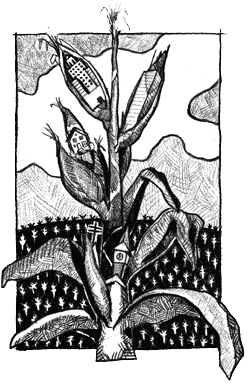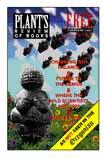


"...the lesson of history is as clear as a sunny day on the Mediterranean, around whose shores the wreckage of so many civilizations lie." (page 270)
At first glance, Topsoil and Civilization seems to be just another faded relic of the 1950s, the book version of some silly black-and-white film with a bad sound track, too many dull zoom shots headed in toward dark wool slacks, and oversized FBI shoes parked on some farmer's crazily cracked mudflats.
Soil, as a subject, will always be homely to those who don't know it well, but this humble book really should not be ignored. Just like its more famous counterparts, Silent Spring and The Population Bomb, it is, sadly, an accurate record of past and present prophecy of the future.
We tend to think of our long-term environmental problems as something entirely new, since no previous civilization has ever caused massive pollution, opened an "ozone hole," encouraged global warming, or buried radioactive wastes with a lifespan of tens of thousands of years. But this book is still germane after so many years because it sheds light on the very first irreparable planetary damage that humans inflicted on themselves--erosion and topsoil degradation resulting from centuries of overcultivation of farmlands, overcutting of forests, and overgrazing of grasslands.
Topsoil, like a vein of gold, an underground pool of oil, or any other natural resource, has taken countless centuries to develop to its present state, and once it it is gone it can not be replaced by humanity's efforts. The process of eroding solid rock to finer particles and the gradual accumulation of vital organic material has been going on for over 350 million years.
According to Carter and Dale, once civilization arrives, this soil building process is reversed and soil destruction begins.
Topsoil and Civilization makes the case that, over the last six thousand years, very few locales have supported a progressive civilization for more than thirty to forty generations (eight hundred to two thousand years). The only exceptions are a few major river valleys--such as those along the Indus and Nile rivers--which regularly flood their banks directly onto the growing areas to deposit fresh, rich soil. (Or at least that was so before the present-day dams).
A civilization can slowly turn a riverside paradise into a wasteland through years of decreasingly productive, increasingly harmful agricultural practices which exhaust the abilities and reduce the depth of the irreplaceable soil, until finally the society may be ripe for conquest themselves, or, if their lands are truly depleted, they wither away in a desert of their own making. Their palaces, irrigation systems, amphitheaters, broad streets, and harbors are eventually buried under blowing dust or, more often, encroaching silt formed by increased storm runoff from treeless slopes. The once-famous Syrian city of Antioch (in what is presently Turkey) has been excavated from beneath 28 feet of silt washed down from the ancient cultivated lands and deforested highlands above.
The book cites prominent ancient writers who noticed declining land productivity in their own time. For example, Plato lamented that the original land of Greece was, by his own time of 300 B.C., like the "skeleton of a sick man" Around 60 B.C. the philosopher and poet Lucretius recognized the seriousness of soil exhaustion in Italy; he thought that the earth itself was dying.
The authors greatly discount the excuse that climactic change was the most important factor in producing the arid wastelands where these ancient cities once flourished. They say rainfall amounts are not as low as the denuded landscape might suggest, and in some areas there a re a few plant types still surviving from antiquity. Also, experiments in our century prove it is still possible to grow cedars in Lebanon, grapes in Palestine, and olives in Tunisia. Today it may be literally the lack of soil that keeps most of these locations from their previous prosperity.
It seems to me that humankind's persistent inability to deal with topsoil degradation probably stems from the fact that erosion is nearly invisible to an individual, even over a lifetime, and erosion itself has a meaningful "lifespan" much longer than even the collective memory of quite a few human generations.
Hopefully, from now on, our unprecedented inability to measure precisely and document visually the exact state of soil conditions in the field should result in a new awareness of erosion that will help make it a more tangible foe.
This book is by no means that dull film we were imagining at the outset. Instead it provides, for the mind's eye, something like time-lapse footage of erosion and topsoil degradation in situ, shot over many centuries. I hope that someday real footage of that kind will be complied, then we will have visual proof of the price that society pays for soil degradation. Until then all we have are a few books like this one, and the buried cities in the dust.



 Return to Facing
Return to Facing